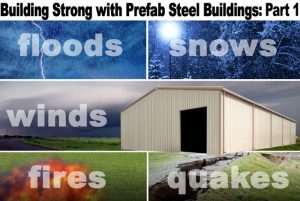Part 1: Safer Structures in Hurricanes, Floods, and Fires
In the wake of recent billion-dollar natural disasters, people are looking to prefab steel buildings for better protection from Nature’s savage furies.
We’ve seen ample evidence in 2017 that Mother Nature’s outbursts inflict unbelievable damage. Now let’s look at what pre-engineered metal buildings can do to counter such natural disasters.
Prefab Steel Buildings in Howling Winds
 Hurricane-force wind damage often results from structural connection failure. Winds create a lifting force against the roof. If the building envelope is breached through a collapsed door or window, the lifting force against the roof can cause nailed connections in wood buildings to fail. When the roof detaches, the walls collapse.
Hurricane-force wind damage often results from structural connection failure. Winds create a lifting force against the roof. If the building envelope is breached through a collapsed door or window, the lifting force against the roof can cause nailed connections in wood buildings to fail. When the roof detaches, the walls collapse.
The strong bolt-and-nut connections of prefab steel buildings hold fast in extreme winds. Consequently, the roof and wall framing remain sound.
RHINO’s heavy-duty buildings will meet or exceed every current building code and wind load requirement at your site— guaranteed. For additional fortification, choose wind-ratings above the required loads.
In addition, RHINO offers wind-rated doors for even greater protection. After all, the stronger your structure, the better your building stands up to the challenge of horrific hurricane-force winds.
Metal Buildings in Flooding Rains
RHINO’S prefab steel buildings include several superior waterproofing features to prevent leaks in fierce rainstorms. Our heavy-duty buildings also boast two distinct advantages over wood-framed structures during floods.
- NO MOLD: After a flood, mold permeates every water-soaked organic material. Proliferating at an inconceivable rate, mold invades even the framing of a lumber-framed structure. As a non-organic material, steel is impervious to mold.
- NO WARPING: Lumber soaks up moisture like a sponge. If wood framing is left standing after a flood, the framing is still at risk. Water-soaked wood studs warp and twist, further stressing connections. The entire frame loosens up, pulling out of shape. Steel framing, however, never absorbs water. Therefore, prefabricated metal buildings retain their strength and shape.
The salt-water flooding associated with coastal surges during hurricanes may have a corrosive effect on a steel building if left untreated. However, this is easily remedied by thoroughly washing the salt residue from the steel.
Steel Buildings in Fires
Wildfires in the Western U.S. have dominated the headlines in recent weeks. Drought following on the heels of above normal rainfall and vegetation growth created an ideal for raging wildfires. As long as the fire continues to find combustible material to feed on and low humidity and strong winds persist, no structure is safe.
However, as a noncombustible material, fire-resistant steel buildings are far less likely to suffer damage in a fire. Wood framing feeds a fire; steel does not.
Commercial-grade steel buildings also earn significant insurance discounts, largely because of the fire-resistant properties of steel framing.
According to the National Fire Protection Association (NFPA), lightning causes an average of 22,600 fires each year.
Wood is a poor conductor of electricity. When lightning hits a wood structure, the current flashes out, striking and igniting any flammable substance nearby— including the framing.
Steel, on the other hand, is a perfect conductor of electricity. If lightning strikes a grounded metal building, the current follows the framing, discharging harmlessly into the ground.
Stronger, Safer, Smarter Building with Steel
With the obvious increase in these natural calamities, soaring property values are sure to make future events even more expensive. Building stronger, safer, prefabricated metal building makes more and more sense in the face of so many natural disasters.
And, surprisingly, steel framing is generally the most affordable building option as well!
Make your next building or re-building project with a RHINO Steel Building System. Discuss your upcoming project with a RHINO metal building specialist today by calling 940.383.9566. And don’t miss part two of this series on prefab metal buildings vs. Mother Nature.
